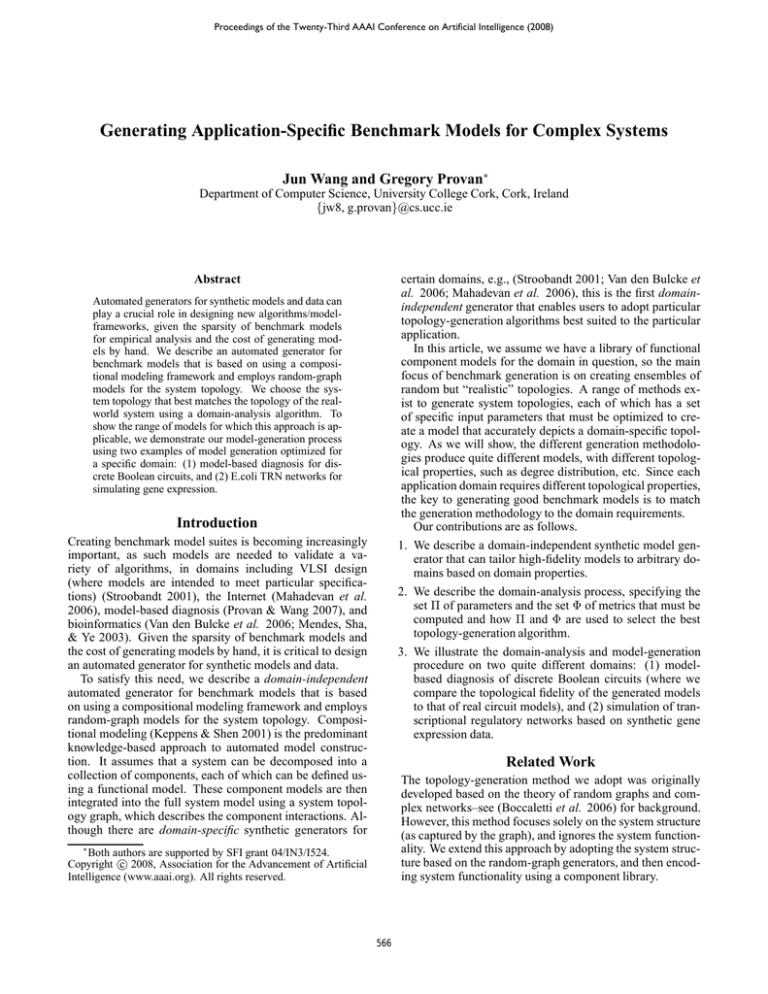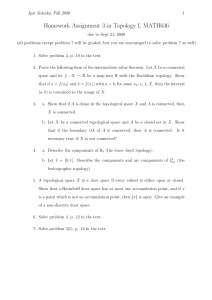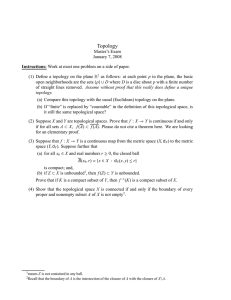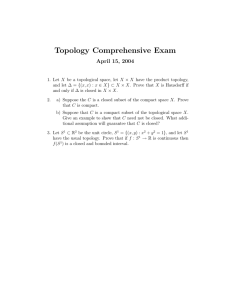Generating Application-Specific Benchmark Models for Complex Systems et
advertisement

Proceedings of the Twenty-Third AAAI Conference on Artificial Intelligence (2008)
Generating Application-Specific Benchmark Models for Complex Systems
Jun Wang and Gregory Provan∗
Department of Computer Science, University College Cork, Cork, Ireland
{jw8, g.provan}@cs.ucc.ie
Abstract
certain domains, e.g., (Stroobandt 2001; Van den Bulcke et
al. 2006; Mahadevan et al. 2006), this is the first domainindependent generator that enables users to adopt particular
topology-generation algorithms best suited to the particular
application.
In this article, we assume we have a library of functional
component models for the domain in question, so the main
focus of benchmark generation is on creating ensembles of
random but “realistic” topologies. A range of methods exist to generate system topologies, each of which has a set
of specific input parameters that must be optimized to create a model that accurately depicts a domain-specific topology. As we will show, the different generation methodologies produce quite different models, with different topological properties, such as degree distribution, etc. Since each
application domain requires different topological properties,
the key to generating good benchmark models is to match
the generation methodology to the domain requirements.
Our contributions are as follows.
1. We describe a domain-independent synthetic model generator that can tailor high-fidelity models to arbitrary domains based on domain properties.
2. We describe the domain-analysis process, specifying the
set Π of parameters and the set Φ of metrics that must be
computed and how Π and Φ are used to select the best
topology-generation algorithm.
3. We illustrate the domain-analysis and model-generation
procedure on two quite different domains: (1) modelbased diagnosis of discrete Boolean circuits (where we
compare the topological fidelity of the generated models
to that of real circuit models), and (2) simulation of transcriptional regulatory networks based on synthetic gene
expression data.
Automated generators for synthetic models and data can
play a crucial role in designing new algorithms/modelframeworks, given the sparsity of benchmark models
for empirical analysis and the cost of generating models by hand. We describe an automated generator for
benchmark models that is based on using a compositional modeling framework and employs random-graph
models for the system topology. We choose the system topology that best matches the topology of the realworld system using a domain-analysis algorithm. To
show the range of models for which this approach is applicable, we demonstrate our model-generation process
using two examples of model generation optimized for
a specific domain: (1) model-based diagnosis for discrete Boolean circuits, and (2) E.coli TRN networks for
simulating gene expression.
Introduction
Creating benchmark model suites is becoming increasingly
important, as such models are needed to validate a variety of algorithms, in domains including VLSI design
(where models are intended to meet particular specifications) (Stroobandt 2001), the Internet (Mahadevan et al.
2006), model-based diagnosis (Provan & Wang 2007), and
bioinformatics (Van den Bulcke et al. 2006; Mendes, Sha,
& Ye 2003). Given the sparsity of benchmark models and
the cost of generating models by hand, it is critical to design
an automated generator for synthetic models and data.
To satisfy this need, we describe a domain-independent
automated generator for benchmark models that is based
on using a compositional modeling framework and employs
random-graph models for the system topology. Compositional modeling (Keppens & Shen 2001) is the predominant
knowledge-based approach to automated model construction. It assumes that a system can be decomposed into a
collection of components, each of which can be defined using a functional model. These component models are then
integrated into the full system model using a system topology graph, which describes the component interactions. Although there are domain-specific synthetic generators for
Related Work
The topology-generation method we adopt was originally
developed based on the theory of random graphs and complex networks–see (Boccaletti et al. 2006) for background.
However, this method focuses solely on the system structure
(as captured by the graph), and ignores the system functionality. We extend this approach by adopting the system structure based on the random-graph generators, and then encoding system functionality using a component library.
∗
Both authors are supported by SFI grant 04/IN3/I524.
c 2008, Association for the Advancement of Artificial
Copyright Intelligence (www.aaai.org). All rights reserved.
566
We assume that a model can be generated from the tuple
(G, B), where G denotes the topology graph, and B denotes
the functionality descriptions for components. The topology
graph G = (V, E) consists of vertices V and edges E and
specifies the topological relations among the system components. Each node v ∈ V corresponds to a component or
input in the system, and each edge (vi , vj ) ∈ E corresponds
to a functional relation between vi and vj . Our component
library specifies a functional description Bi for each component vi in the system being modeled.
This work is most closely related to domain-specific
model generators, which exist for circuits (Stroobandt 2001)
and biological interaction kinetics models (Van den Bulcke
et al. 2006). Our approach is different from either of these
approaches, in that we make no prior assumptions about domain properties, but rather compute the domain properties
necessary for model generation. Our model generation approach differs from related work in VLSI auto-generation,
e.g., (Stroobandt 2001), in several ways. The VLSI approach emphasizes circuit design for circuit optimization
and simulation after placement and routing; in contrast, our
approach focuses on topological and organizational principles of circuits, and can be used for a wider variety of applications, including the diagnostics applications we report.
Existing biological network generators, e.g., (Van den Bulcke et al. 2006; Mendes, Sha, & Ye 2003) use randomgraph models that have unsuccessfully reflected the underlying structure of biological networks (Chung et al. 2003;
Hormozdiari et al. 2007). Van den Bulcke et al.(2006) proposed an alternative topology generation approach for transcriptional regulatory networks (TRNs) by selecting subgraphs from previously described TRNs. Although this approach captures some topological characteristics of TRNs,
it is not scalable and depends on the availability of accurate
data of existing TRNs. We improve the topology generator
with more biologically plausible models.
This paper improves upon the model generation approach
of (Provan & Wang 2007) in several ways. First, it explicitly
defines a domain-analysis phase. Second, it extends and improves upon the topology generation algorithms for creating
the underlying system structure, and examines a wider range
of metrics for empirically evaluating synthetic networks.
Compositional modelling uses a set of functional component models, together with a specification of component interactions (called a “scenario” in (Keppens & Shen 2001)) to
generate useful (mathematical) models. Our approach differs from that of (Keppens & Shen 2001) in that we create the system structure, or scenario using model generators instead of manual work. Further, although the modelgeneration (or compositional modeling) approach has primarily been applied to physical systems, it can be applied to other domains, such as socio-economic, ecological and biological systems (Van den Bulcke et al. 2006;
Mendes, Sha, & Ye 2003).
Plausible algorithms
with appropriate
values of parameters
Domain
Models
Domain
analysis
Objective
topological
metrics
Topology
Generation
Synthetic
Models
Component
Library
Figure 1: Automated model generation framework.
As shown in Figure 1, we generate benchmark models in
a three-step process.
1. analyze existing domain models to extract important
model properties;
2. generate the (topology) graph Ĝ underlying each synthetic model;
3. assign components to each node in Ĝ, to create the
system-level functional model Ψ̂;
For example, electronic circuits can be viewed as graphs
in which nodes are electronic components (such as logic
gates in digital circuits) and edges are wires in a broad
sense (Cancho, Janssen, & Solé 2001). In gene TRNs, nodes
represent genes and edges correspond to regulatory interactions at transcriptional level between the genes (Van den
Bulcke et al. 2006; Mendes, Sha, & Ye 2003).
As another example, in auto-generating TRN models,
each node in Ĝ is instantiated as a gene, and the interaction
kinetics between the genes are quantitatively modeled using a set of ordinary differential equations (ODEs) (Van den
Bulcke et al. 2006; Mendes, Sha, & Ye 2003). For each
combination of a gene and its regulators, a proper enzyme
kinetic equation is selected, depending on the number of activators and repressors and on settings that control the fraction of complex interactions (Van den Bulcke et al. 2006).
Modeling Framework
Topological Model Selection and Generation
This section describes our approach for generating benchmark models for compositional domains. A domain D is
compositional if a system model from D can be composed
from model components, each of which is defined by a component functional model. Our approach is applicable to any
compositional domain, since (a) the underlying topological models can be optimized using appropriate parameters
to approximate virtually the structure of real-world complex systems (Boccaletti et al. 2006), and (b) functionality
is incorporated into the system model using a componentlibrary, where components can be developed for any domain
in which the system models are decomposable.
To generate a synthetic network Ĝ using an algorithm A, we
provide to A a set Π of input parameters, and then measure
the properties of Ĝ (e.g., degree distribution) using a set Φ of
graph metrics (Mahadevan et al. 2006) to compare the properties of the real and synthetic networks. For example, the
preferential attachment (PA) (Boccaletti et al. 2006) algorithm requires the number of nodes and edges of Ĝ as input
parameters.
There is a wide range of generation algorithms available,
e.g., (Boccaletti et al. 2006; Chung et al. 2003). Table 1 classifies the space of topology-generation approaches
567
Optimization-Based Generators: Rather than explicitly
replicate of statistical properties, the Optimization approach
(OPT) use an optimization framework to model the mechanisms driving network growth. This approach gives rise
to power-laws in graph degree distributions (D’Souza et al.
2007; Mathias & Gopal 2001). The OPT model formulates a
weighted objective function overP
conflicting system properties ξi and weights λi , e.g., f = ni=1 ξi · λi , and trades off
the properties using the weights λi . For example, in circuit
design we may trade off wire-length W L and logic-depth
LD, where f = λLD + (1 − λ)W L. We have used simulated annealing to search for the cost minimum of the objective function (Kirkpatrick, Gelatt, & Vecchi 1983).
An explanatory model with parsimonious parameters can
capture the general principles or structures of real-world systems, but it is hard to match all topological metrics simultaneously and perfectly As a consequence, we need to identify
and understand the essential metrics that are responsible for
certain behaviors of certain applications, and focus on specified metrics necessary for capturing the domain-specific requirements of different applications. For instance, if we generate a model for evaluating the complexity of discrete MBD
algorithms, we need first to focus on domain-specific (jointree) metrics (Provan & Wang 2007), which are more important than regular metrics.
In steps 3 and 4, after a plausible model is selected, we
further optimize its topology by searching over appropriate
values of input parameters to minimize the difference between G and Ĝ in the specified metrics. We automatically
scan appropriate values in a specific range (within a reasonable interval); if the topological metrics are monotonic functions of input parameters (such as α in the SPA model and
pr in the SWG model), we can speed up the search process
using strategies like the binary search.
that our model-generation tool supports in terms of the key
properties of the approaches, together with their corresponding parameters, recommended applications, and associated
model-generation computational costs. We classify the generator models into two main groups, as shown in column 1 of
Table 1: explanatory models, which attempt to capture the
underlying generation process of the complex system in the
resulting model, or descriptive models, which capture the
topology alone. For example, the explanatory Preferential
Attachment model is designed to capture the growth process
of complex systems, in which new network structure preferentially forms around existing sub-structures (Boccaletti et
al. 2006). In contrast, the descriptive dK-series model (Mahadevan et al. 2006) just captures higher-order degree correlation distributions, independent of any complex system
growth process. Another dimension in model selection encompasses trade-offs between: (1) complexity of a model
and the number of metrics it tries to reproduce, and (2) its
explanatory power and associated generality. The process
of generating high-fidelity synthetic models differs based on
this basic classification. In the following, we summarize our
model selection process (using these two classes), and then
review the different generation approaches.
Model Selection using Explanatory Models
To select an explanatory model, we must analyze the domain D to (1) select the most appropriate topology generation algorithm A from a set A of candidate algorithms, and
(2) provide parameters for A that are best suited to generating high-fidelity networks. We select an explanatory model
from a set A of possible generators (see Table 1) as follows:
1. analyze real-world network G, together with key properties in domain D, to specify a topological metric set Φ
according to domain-specific requirements;
2. generate potential algorithm set A′ ⊆ A based on analytical results in step 1;
3. optimize parameters Πi of each algorithm Ai ∈ A′ to
match G in terms of specified topological metrics Φ, and
put the Ai into the result set  if it can match G with
appropriate values of Πi ;
4. if  contains multiple algorithms, we compute additional
metrics Φ′ , according to further requirements in D, and
continue to evaluate and select algorithms in terms of Φ′ .
Model Selection using Descriptive Models
The dK-series Model generator (Mahadevan et al. 2006)
has as its primary input parameter an integer d, which allows one to specify all degree correlations within d-size subgraphs of a given graph G1 . 1K captures the degree distribution Pk and is equal to the generalized random graph
(GRG) (Boccaletti et al. 2006). 2K-graphs reproduce the
joint degree distribution, and 3K-graphs consider interconnectivity among triples of nodes.
Given a descriptive dK-series algorithm, we generate a
synthetic model Ĝ by increasing the input parameter (d) until the generated graph Ĝ matches the properties of the realworld graph G with sufficient fidelity. Increasing values of
d capture progressively more properties of G, at the cost of
more complex representation of the probability distribution
and dramatically increasing computational complexity.
Although the dK-series model generally can capture regular topological metrics better than explanatory models due
to the number of constraints imposed, the model doesn’t provide insights into the driving force shaping the network, and
When using an explanatory model, we first restrict the
possible algorithms based on Model Focus (cf. column 2
of Table 1), i.e., whether the domain D provides information to to generate a model from topological parameters, or
using an optimization approach given the system’s global
objective function. We briefly discuss these two approaches.
Topology-Based Generators: Given the wide range of
graph generators defined in the literature, e.g., (Boccaletti
et al. 2006; Chung et al. 2003), we have selected four of
the most important approaches, i.e., the small-world graph
(SWG), Preferential Attachment (PA), Spatial Preferential
Attachment (SPA) and Partial Duplication (PD) models.
Each approach has particular properties, which lend themselves to modeling particular domains with differing fidelity.
1
Actually, a large number parameters are needed for every value
of d in real implementations, but d is the governing parameter.
568
Table 1: Topology Generation Approaches. Input parameters for generation algorithms are as follows: n—node number; m—edge number;
pr —rewiring probability; α—spatial factor; gs —seed network; pd —duplication probability; λi —trade-off weight; d—subgraph size
Generation
Key
Recommended
Computational
Model
Model
Parameters
Algorithm
Properties
Applications
Cost
Class
Focus
Topological
Explanatory Properties
Functional
Optimization
Descriptive
Topological
properties
Small-world Graph
(SWG)
Preferential Attachment (PA)
Spatial Preferential
Attachment (SPA)
Partial Duplication
(PD)
Exponential degree distribution
Power law degree distribution
Power law degree distribution with cutoff
Power law degree distribution
n, m, pr
Technological systems
Low
n, m
WWW, social and citation networks
Spatial
technological
systems
Biological systems
Low
Multi-constraint
Optimization
(OPT)
dK-series
Power law degree distribution with cutoff
λi
Technological and transportation systems
High
All degree correlations in
d-sized subgraphs
d
Technological and biological systems
High
it lacks predictive and rescaling power for explaining network growth. Our experiments on diagnosis model generation also showed that the dK-series model is not flexible
enough for fitting more complicated joint-tree metrics.
n, m, α
n, m, gs , pd
Medium
Low
of all sub-graphs with specified sizes.
Join-tree Metrics: In many applications involving inference over systems Ψ, e.g., probabilistic inference and
model-based diagnosis, the inference complexity has been
found to be dependent on parameters of the join-tree T of
the graph G of Ψ (Darwiche 1998).2 As a consequence, for
applications involving system inference, we use appropriate
join-tree metrics, such as the largest clique size µ(T )(Darwiche 1998), which can be used to represent the inference
complexity of the system.
Summary of Topological Metrics
We assume that we have a correct set of functional components B, meaning that it is the system topology G which
is the source of model fidelity. In this case, we need
to identify metrics for topology comparison, i.e., methods to define some topological distance measure δ(G, Ĝ).
There are many metrics used to analyze and compare a
system’s topological structures (Boccaletti et al. 2006;
Mahadevan et al. 2006). The following list is not complete,
but we believe it is sufficiently diverse and representative to
be used as good examples of topological similarity.
Standard Metrics: Most research on topological analysis of complex systems focuses on a subset of graph properties, in particular on the characteristic path length L̄, average clustering coefficient C̄ and degree distribution Pk (Boccaletti et al. 2006). The L̄ measures the typical separation
between two nodes in the network is given by the average
shortest path length. The clustering coefficient C characterizes the degree of cliquishness of a typical neighborhood (a
node’s immediately connected neighbors), and the mean coefficient C̄ is the average over C for all nodes in G. The
degree distribution Pk specifies the probability of a node
having degree k.
Extended Topology Metrics: We focus on the following
extended metrics.
Ps-Metric: The s-Metric of graph G is defined as s(G) =
edge(vi ,vj ) di dj , where (vi , vj ) is the edges in the graph,
and di and dj are the degrees of the node vi and vj respectively. The s-Metric is closely related to betweenness,
degree correlation and graph assortativity(Mahadevan et al.
2006).
Subgraph Frequency Distribution: P (Fx (G)) defines that
probability of subgraph of type x occurring in graph G. The
distribution P (Fx (G)) enables us to analyze the frequencies
Examples of High-Fidelity Model-Generation
To demonstrate the range of models for which this approach
is applicable, we describe model-generation for two radically different domains, E.coli TRN networks for simulating
gene expression, and MBD inference of discrete circuits.
TRN Inference Benchmark
The validation of algorithms used to infer the structure of
gene regulatory networks, based on expression data from
high throughput microarrays, requires benchmark data sets
for which the underlying network is known. Since experimental data sets of the appropriate size and design are usually not available, there is a clear need to generate wellcharacterized synthetic data sets that allow thorough testing of learning algorithms in a fast and reproducible manner (Mendes, Sha, & Ye 2003; Van den Bulcke et al. 2006).
So we need a network generator that creates synthetic TRNs
and produces simulated gene expression data that approximates experimental data. TRN model generation provides a
good example to demonstrate the applicability of our general
model generator to biological domains, and we use the wellknown TRN of E. coli collected by Shen-Orr et al. (Van den
Bulcke et al. 2006) as the targeted domain model.
2
Roughly speaking, the join-tree T of a graph G is a topological
transformation of G into a tree of cliques, where a clique is a fullyconnected subgraph (Darwiche 1998).
569
Explanatory Model Approach We generated the synthetic TRN model based on the first three steps in the process
of model selection, as discussed in the previous section.
Step 1: We analyzed the E.coli TRN model and found that
it displays a clear power law degree distribution as shown in
Figure 2. Since the synthetic TRN models are used to generate gene expression data (on which the accuracy of reverseengineering algorithms is evaluated), we only need to measure the model fidelity in terms of regular topological metrics. For this task, we use the degree distribution Pk , which
is the most fundamental and widely-used metric. Pk can be
simplified as an exponent β when following a power law;
the β of the E.coli TRN model is about 2.5.
Step 2: According to key properties of the potential algorithms listed in Table 1, both the PA and PD model can
generate a power law degree distribution, and thus are selected as candidate algorithms.
Step 3: The parameters in the P A(n, m) and P D(n, m,
gs , pd ) algorithms are optimized in terms of β; n and m are
assigned as the numbers of nodes and edges in the actual
TRN model respectively. We carefully sampled an appropriate subgraph of the TRN of E. coli using the method in
(Van den Bulcke et al. 2006) as the seed graph gs . Chung et
al. (2003) showed that in the PD model, β is a monotonically
decreasing function of pd , so we can approximate the degree
distribution of the TRN of E. coli by adjusting pd . The PA
model’s value of β is fixed at about 3, but the PD model can
generate β in a wide range (1 ∼ 3), consistent with various real biological networks(Chung et al. 2003). Figure 2
shows that the PD model (pd = 0.2) closely matches the
actual TRN, much better than can the PA model.
Cumulative node number
1000
Table 2: The statistics on the average clustering coefficient C̄, characteristic path length L̄, and s-Metric of E. coli and the graphs generated by the 3K-series model (averaged over 100 graphs).
C̄
Model L̄
s-Metric
E. coli 4.83371 0.11018 26621
3K
4.64722 0.11018 26621
Model-Based Diagnosis Benchmark
The Model-based diagnosis (MBD) problem determines
whether an assignment of failure status to a set of modevariables is consistent with a system description and an observation (e.g., of sensor values). For the target domain of
ISCAS85 benchmark circuits (Harlow 2000), we synthesized topological models having the identical numbers of
nodes and edges, and tried to characterize average-case diagnosis inference complexity in real circuits.
Explanatory Model Approach We generated MBD models using the four steps shown below.
Step 1: We used as our primary metric the maximum
clique size µ(T ) in the compiled join-tree structure, which
is a typical complexity measure for this type of model (Darwiche 1998), and is correlated to the tail length of degree
distribution Pk (Provan & Wang 2007). As shown in Figure 3, the tail of Pk must be modeled well, since it defines
the high-degree nodes that contribute to large cliques in the
join-tree, and hence high complexities using join-tree metrics. We have empirically showed that most of the ISCAS85
circuits have power law degree distributions with sharp cutoffs, which can be well characterized by the SPA and OPT
models in Table 1. The SWG model naturally has a sharp
cutoff in its exponential degree distribution, and can vary
the tail length of its degree distribution in a limited range.
Step 2: Based on the above analysis, the SPA, OPT, and
SWG model can be selected as potential candidates.
Step 3: We automatically optimized parameters in each
model to match the µ(T ) of real circuits. Experiments
showed that all selected models can match real circuits
with appropriate parameters. For example, the typical circuit C432 can be matched by the SWG model with pr ≃
0.28 (Provan & Wang 2007), the SPA model with α ≃
3.7 (as shown in Figure 3). We, along with Barthelemy
(2003) have found that, under appropriate parameters, the
SPA model can generate structures similar to that of the
OPT model. However, the computational cost of modelgeneration using the OPT model is significantly higher than
that of using the SPA model, so we use the SPA model as an
efficient alternative of the OPT model.
Step 4: Since both the SPA and SWG model fit the real
circuits well in terms of µ(T ), we can further refine the
model selection by other topological metrics, such as degree
distribution Pk . Based on Pk , the SPA model’s power-law
distribution can match real circuits better than can the SWG
model’s exponential distribution.
E. coli
PD(p=0.2)
PA
100
10
1
1
10
Degree
100
Figure 2: The cumulative degree distribution of E. coli and the
corresponding graphs generated by the PD and PA model (averaged
over 100 runs).
dK-series Approach Table 2 shows that the graphs generated by the dK-series model perfectly match common graph
metrics of the E. coli TRN, including Pk when d = 3.
The experimental results show that the dK-series is a good
model for TRN benchmark generation. However, compared
with the parsimonious PD model, the dK-series model is
more computationally expensive and less flexible, since it
requires as input parameters multiple degree correlations
within d-sized subgraphs of an existing TRN.
dK-series Approach When d = 3, the dK-series model
can match almost all common circuit topological metrics
perfectly, as also occurs in the case of the TRN and Internet
570
1e+024
1e+022
24
1e+020
22
1e+018
20
1e+016
18
Complexity of C432
1e+014
References
max degree
max clique size
machine learning techniques. Third, further improvements
in topology-generators are necessary to increase the fidelity
of the synthetic models.
26
max clique size
max degree
Barthlemy, M. 2003. Crossover from scale-free to spatial
networks. Europhysics Letters 63:915–921.
Boccaletti, S.; Latora, V.; Moreno, Y.; Chavez, M.; and
Hwang, D.-U. 2006. Complex networks : Structure and
dynamics. Physics Reports 424(4-5):175–308.
Cancho, R. F. i.; Janssen, C.; and Solé, R. V. 2001. Topology of technology graphs: Small world patterns in electronic circuits. Physical Review E 64(4):046119.
Chung, F. R. K.; Lu, L.; Dewey, T. G.; and Galas, D. J.
2003. Duplication models for biological networks. Journal
of Computational Biology 10(5):677–687.
Darwiche, A. 1998. Model-based diagnosis using structured system descriptions. J. Artif. Intell. Res. (JAIR)
8:165–222.
D’Souza, R. M.; Borgs, C.; Chayes, J. T.; Berger, N.; and
Kleinberg, R. D. 2007. Emergence of tempered preferential
attachment from optimization. Proc. Natl. Acad. Sci. USA
104(15):6112–6117.
Harlow, J. E. 2000. Overview of popular benchmark sets.
IEEE Design and Test of Computers 17(3):15–17.
Hormozdiari, F.; Berenbrink, P.; Przulj, N.; and Sahinalp,
S. C. C. 2007. Not all scale-free networks are born equal:
The role of the seed graph in ppi network evolution. PLoS
Comput Biol 3(7).
Keppens, J., and Shen, Q. 2001. On compositional modelling. Knowl. Eng. Rev. 16(2):157–200.
Kirkpatrick, S.; Gelatt, C. D.; and Vecchi, M. P. 1983. Optimization by simulated annealing. Science, Number 4598,
13 May 1983 220, 4598:671–680.
Mahadevan, P.; Krioukov, D. V.; Fall, K. R.; and Vahdat, A.
2006. Systematic topology analysis and generation using
degree correlations. In SIGCOMM, 135–146.
Mathias, N., and Gopal, V. 2001. Small worlds: How and
why. Physical Review E 63:021117.
Mendes, P.; Sha, W.; and Ye, K. 2003. Artificial gene
networks for objective comparison of analysis algorithms.
Bioinformatics 19 Suppl 2.
Provan, G. M., and Wang, J. 2007. Automated benchmark
model generators for model-based diagnostic inference. In
IJCAI, 513–518.
Stroobandt, D. 2001. Analytical methods for a priori wire
length estimates in computer systems. Ph.D. dissertation:
Ghent University.
Van den Bulcke, T.; Van Leemput, K.; Naudts, B.; van Remortel, P.; Ma, H.; Verschoren, A.; De Moor, B.; and Marchal, K. 2006. Syntren: a generator of synthetic gene expression data for design and analysis of structure learning
algorithms. BMC Bioinformatics 7.
16
1e+012
14
1e+010
1e+008
12
1
2
3
4
5
spatial constraint α
6
7
8
Figure 3: The inference complexity and maximal degree of the
SPA model corresponding to the circuit C432 (averaged over 100
runs).
Table 3: The inference complexity of C432 and corresponding dKseries Models (d = 1, 2, 3). All values of three models are averaged over 100 graphs respectively.
Model
C432
1K
2K
3K
max clique size 1.4e14 8.9e17 3.3e16 1.8e16
modeling (Mahadevan et al. 2006). Table 3 shows, however,
that d = 3 provides insufficient fidelity to match µ(T ) metrics for MBD benchmark generation; it also shows that increasing d can generate random graphs with increasing levels of fidelity of inference complexity. For d > 3 the computational complexity increases dramatically, and the size of
the generated random-graph ensemble decreases exponentially as well. In this case, the dK-series model is unsuitable
for diagnosis benchmark generation, compared with the SPA
and the SWG model.
Conclusions
We have described a model-generation tool that can be used
for compositional systems in which we use a component
library B, together with a system topology G, to generate
benchmark models for a wide range of systems. We assumed
a library B, and focused on the problem of topology generation. We described a domain-analysis algorithm that computes model properties for selecting the topological model
generator best suited to creating high-fidelity networks.
We applied model-generation to two radically different
domains, E.coli TRN networks for simulating gene expression, and MBD inference of discrete circuits, to demonstrate
the range of models for which this approach is applicable.
For each domain we showed how the topological properties,
together with the functional requirements (e.g., simulation,
diagnostic inference), enabled us to tune the generated network topology to the application.
Much work remains to be done in automated model generation. First, more component libraries need to be created to
take advantage of this approach. Second, the domain analysis approach could be further improved through adoption of
571





